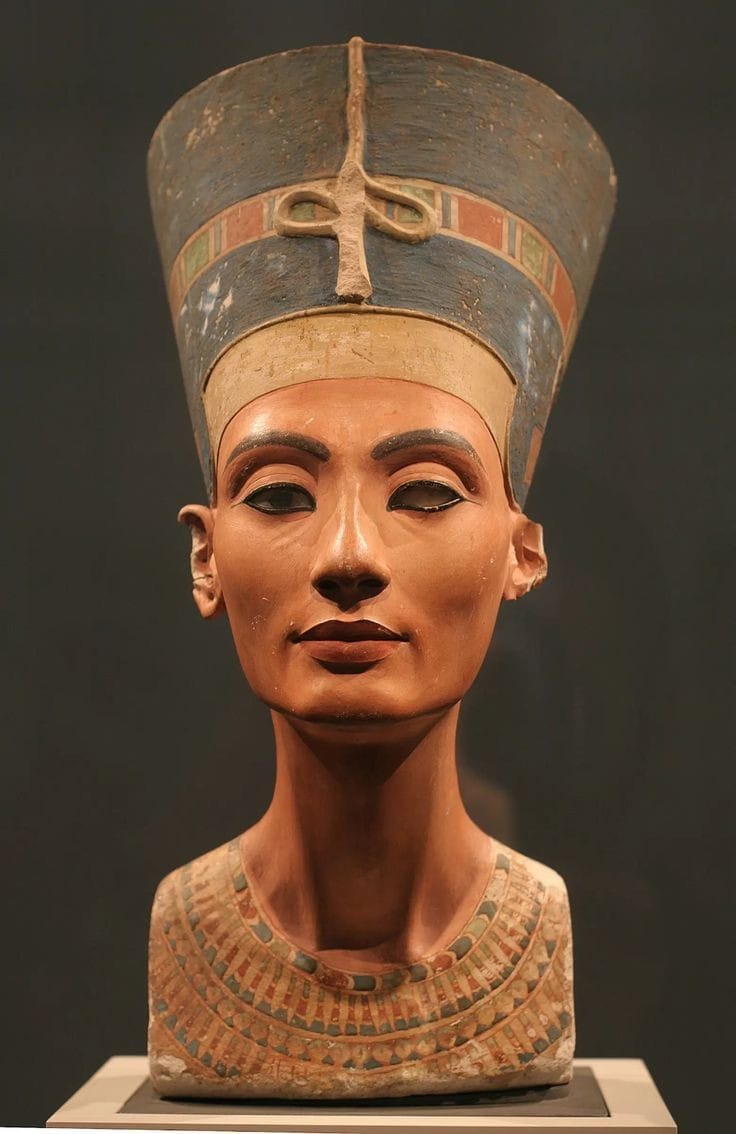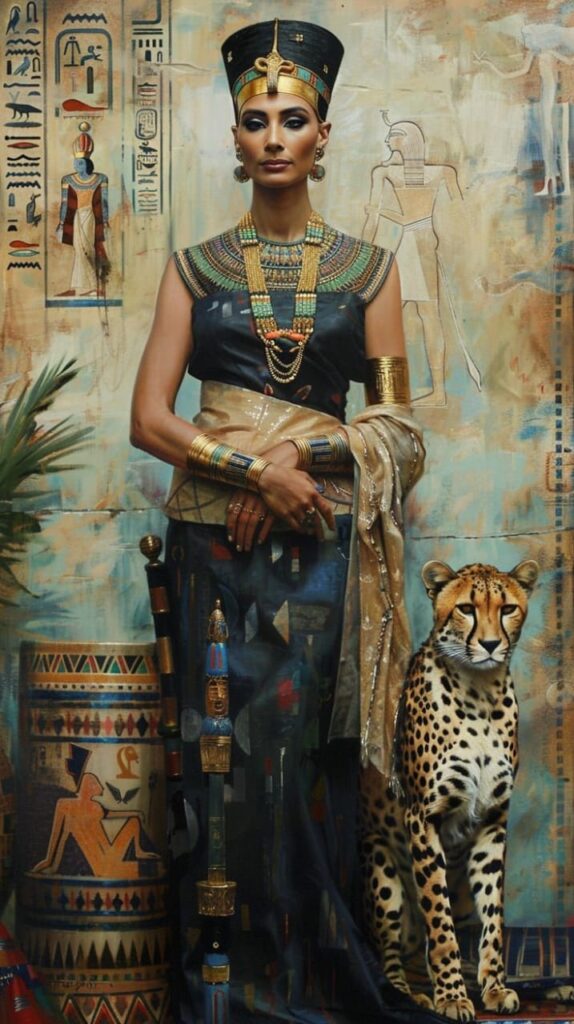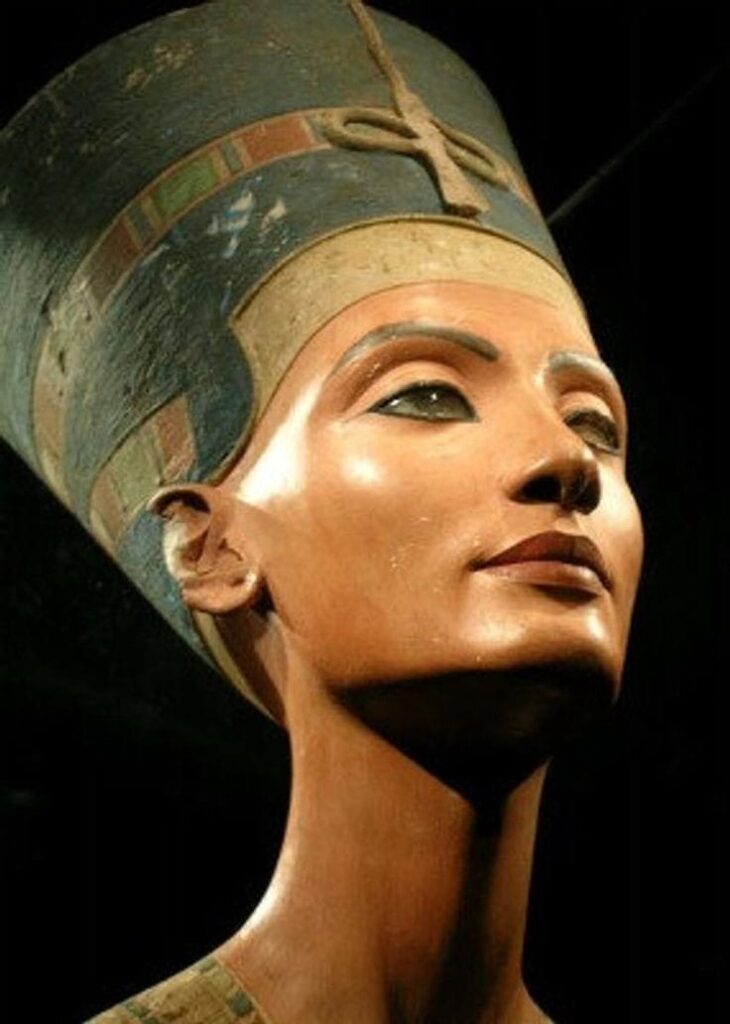“Nefertiti: From the Throne of Egypt to the World’s Museums – The Journey of the Bust and the Secrets of the Mysterious Queen”

“What secrets does the bust of Nefertiti hide and how does it tell the story of the mysterious queen who enchanted the world?”
Nefertiti, whose name means “the beautiful one who came”, was an influential queen in ancient Egypt, beautiful and powerful, who married the pharaoh Akhenaten and his father, the famous golden king Tutankhamun, during the 18th dynasty.
During the 14th century BC. Her reign coincided with a period of dramatic change, as Akhenaten attempted to revolutionize Egyptian religion by worshipping Aten, the sun disk.
Queen Nefertiti shared with her husband the worship of the new religion, which is the worship of Aten (the sun disk), and she and her husband were the mediator between the people and Aten. One of her royal titles is the Great Queen. Nefertiti bore Akhenaten six daughters:
Meritaten, who was born in Thebes
Meketaten.
Ankhesenpaaten.
Neferneferuatentashere.
Neferneferure.
Stepenre.
Nefertiti Bust

Nefertiti’s beauty was immortalized in the famous bust discovered in 1912, which remains one of the most iconic symbols of ancient Egyptian art. With its stunning realism and detailed craftsmanship, the bust has captivated historians and art lovers alike, symbolizing her allure and important role in Egyptian culture.
The most famous depiction of Nefertiti is a limestone bust discovered by German archaeologist Ludwig Borchardt in 1912. Known for its exquisite craftsmanship and stunning beauty, this statue is one of the most iconic artifacts of ancient Egypt. The statue depicts Nefertiti with an elegant, elongated neck and a calm, regal expression, embodying the art and aesthetics of her time.
The statue was found in the workshop of“Nefertiti: From the Throne of Egypt to the World’s Museums – The Journey of the Bust and the Secrets of the Mysterious Queen” intriguing as the artifact itself.
At the time of its discovery, Egypt was under Ottoman and then British rule, complicating the legal and ethical considerations surrounding the antiquities. The bust was part of the collection of the German Oriental Company, which had exclusive excavation rights in Egypt. This arrangement allowed the artefacts to be sent to Europe, often sparking controversy over the ownership and repatriation of these treasures.
The bust was shipped to Germany and eventually became a centrepiece of the Egyptian Museum at the Neues Museum in Berlin. Over time, it has become a symbol of ancient Egyptian art and culture, but its presence in Germany has been controversial. In recent years, 111 years later, there have been calls from Egypt for the bust to be returned, reflecting ongoing debates over the ownership and repatriation of cultural heritage.
The journey of the Nefertiti bust from Egypt to Germany highlights broader issues in the field of archaeology and cultural heritage, and despite the controversy, the Nefertiti bust remains a testament to ancient Egyptian art and continues to captivate audiences around the world.
Nefertiti’s mother-in-law
Nefertiti’s relationship with her mother-inlaw, Queen Tiye, was a fascinating aspect of her story. Tiye, the Great Royal Wife of Pharaoh Amenhotep III and mother of Akhenaten, was a powerful and influential figure in her own right. Her presence in Nefertiti’s life was significant, providing much of the context in which Nefertiti’s story unfolded.
Tie was known for her strong political influence and involvement in state affairs, which was unusual for women of her time. She was not only queen, but also a prominent advisor to her husband and later son, Akhenaten. Tiye’s fame and political acumen set a high bar for Nefertiti, who would need to navigate the complexities of royal life and rule.
She provided guidance in her new role as queen
Despite her high status, Nefertiti’s life and legacy are shrouded in mystery. After Akhenaten’s death, she disappeared from historical records, and her final resting place remains unknown. Some speculate that she may have ruled as pharaoh herself under the name Smenkhkare, though this theory remains unproven.
The quest to understand Nefertiti invites us to look beyond the surface, to explore how her life and legacy continue to inspire fascination and debate. Her story is a testament to how the allure of an individual can transcend time, influencing how we view art, power, and historical legacy today.








